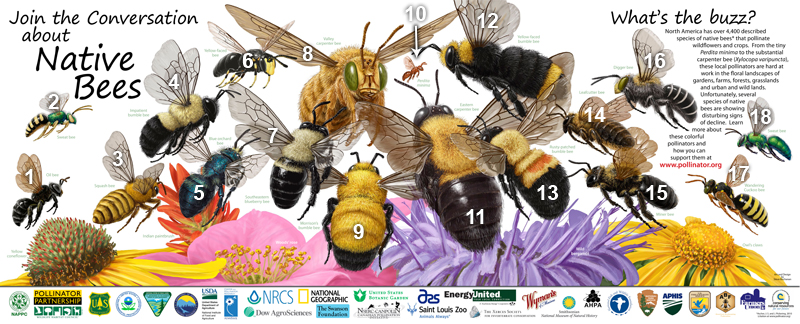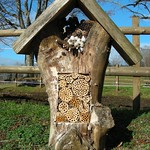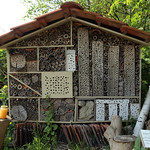
The idea of starting a bee sanctuary at Half Hill Farm is taking on a life of its own.
As we weeded the garden before the rain, I caught this alfalfa leafcutter bee (pictured above) weaving in an out of the tomatoes. This and a couple other solitary bees were pollinating the buds of the Giant Beef Steaks and had taken up residence in the bamboo supports. We’ve seen more solitary bees than honey bees this year.
Hosting solitary bees is an obvious first step to bee keeping. They aren’t social (so no swarm), rarely sting, don’t make honey, and are great pollinators. Due to colony collapse disorder of hives, some experts are suggesting people start hosting solitary bees.
Discover the diversity of native bees:

1. Macropis nuda.
2. Agapostemon texanus. US sweat bee
3. Peponapis pruinosa. Squash & gourd bees
4. Bombus impatiens. The Impatient Bumble Bee
5. Osmia lignaria. The Blue Orchard Bee
6. Hylaeus sp.
7. Habropoda laboriosa. The Southeastern Blueberry Bee
8. Xylocopa varipuncta. The Valley Carpenter Bee
9. Bombus morrisoni. Morisson’s bumble bee |
10. Perdita minima.
11. Xylocopa virginica. Eastern Carpenter Bee
12. Bombus vosnessenskii.
13. Bombus affinis.
14. Megachile sp. Leafcutter bees
15. Andrena cornelli. Miner bees
16. Anthophora centriformis. Digger bees, or anthophorids
17. Nomada sp. The Wandering Cuckoo Bee
18. Augochorella pomoniella. Sweat bees |
The idea of creating a bee sanctuary at the farm was inspired by May Berenbaum, Department Chair of Entomology at the University of Illinois at Urbana-Champaign in this NPR story on bee deaths reaching a crisis point. Her suggestion: “Plant more flowers!”
Judging from the number of bumbling mason bees we have, I’d also suggest building more barns. We have to have about 15 of them turning the barn wood to swiss cheese, but they happen to be our #1 pollinator for our cucumbers. As we continue to plan a small sanctuary for both hives and solitary bees, we’re going to test placing a few of these simple mason bee condos to see if it creates a more hospitable alternative.
If you would like to collaborate on the bee sanctuary project, let us know. In the meantime, check out some of these more elaborate solitary bee temples we hope to graduate to very soon!




Read More:

 We cut the scapes off to force the plant to send its energy to the bulb, remove the flowering top and use them much like chives in food. They have an amazing fresh flavor that isn’t as strong as garlic.
We cut the scapes off to force the plant to send its energy to the bulb, remove the flowering top and use them much like chives in food. They have an amazing fresh flavor that isn’t as strong as garlic.





